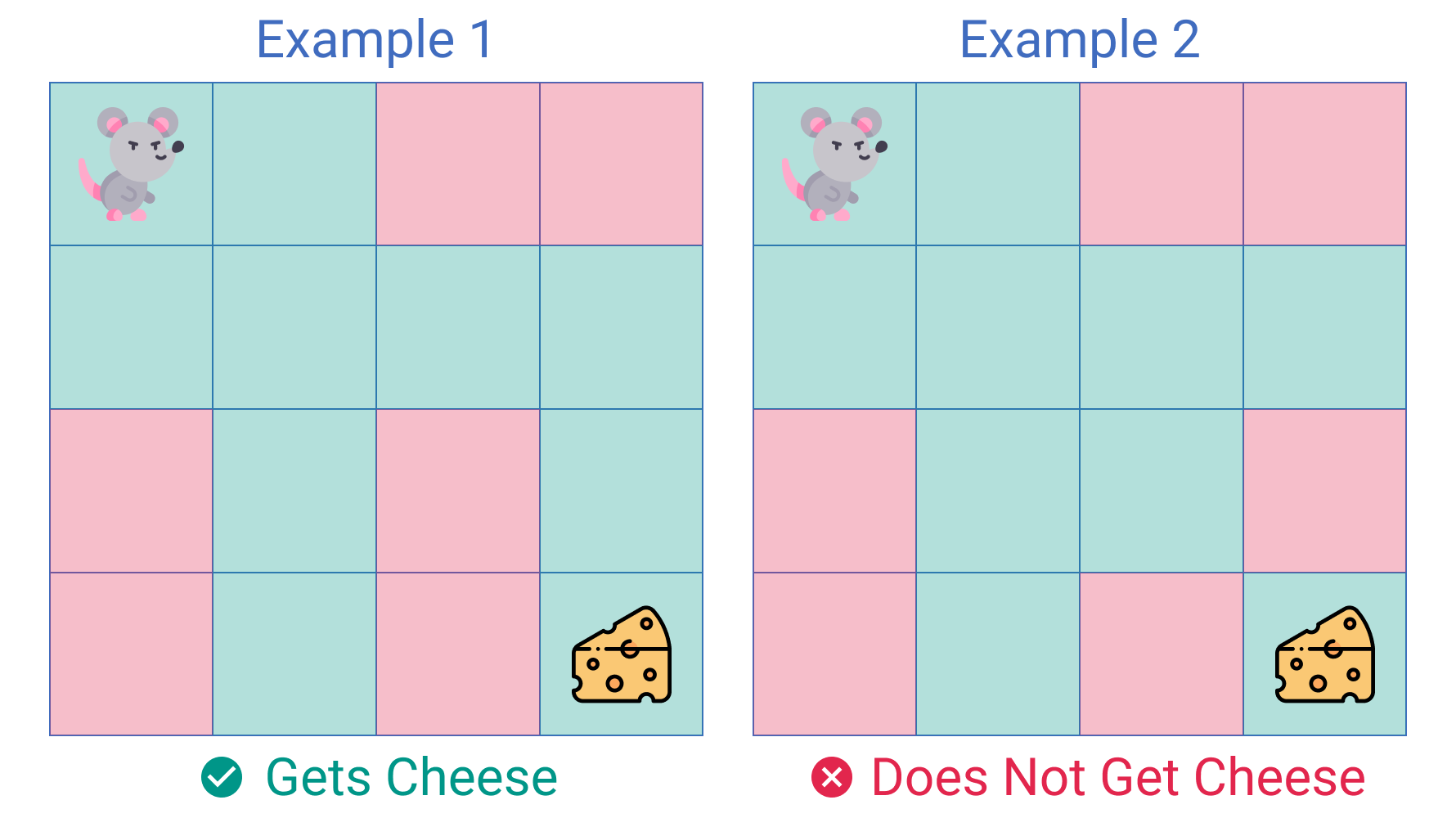 Logicmojo - Updated Jan 2, 2023
Logicmojo - Updated Jan 2, 2023
Problem Statement: Rat In A Maze
You are given a maze in the form of a matrix of size n * m. Each cell is either clear or blocked denoted by 1 and 0 respectively. A rat sits at the top-left cell and there exists a block of cheese at the bottom-right cell. Both these cells are guaranteed to be clear. You need to find if the rat can get the cheese if it can move only in one of the two directions - down and right. It can’t move to blocked cells.

Approach: Backtracking
Backtracking is an algorithmic-technique for solving problems recursively by trying to build a solution incrementally. Solving one piece at a time, and removing those solutions that fail to satisfy the constraints of the problem at any point of time (by time, here, is referred to the time elapsed till reaching any level of the search tree) is the process of backtracking.

Form a recursive function, which will follow a path and check if the path reaches the destination or not. If the path does not reach the destination then backtrack and try other paths.
Algorithm:
1. Firstly, create a matrix to store your solution. It should contain all zeros and should be of the same size as the maze matrix.
2. Make a recursive call with the position of the rat in the matrix: initial maze matrix, solution matrix
3. If the position provided is invalid, return from the function.
4. Otherwise, mark the position as 1 in the solution matrix.
5. Recursively call for position (i+1, j), (i, j+1), (i-1, j), and (i, j-1).
C++ Implementation:
/* C/C++ program to solve Rat in a Maze problem using backtracking */ #include<stdio.h> // Maze size #define N 4 bool solveMazeUtil(int maze[N][N], int x, int y, int sol[N][N]); /* A utility function to print solution matrix sol[N][N] */ void printSolution(int sol[N][N]) { for (int i = 0; i < N; i++) { for (int j = 0; j < N; j++) printf(" %d ", sol[i][j]); printf(""); } } /* A utility function to check if x,y is valid index for N*N maze */ bool isSafe(int maze[N][N], int x, int y) { // if (x,y outside maze) return false if(x >= 0 && x < N && y >= 0 && y < N && maze[x][y] == 1) return true; return false; } bool solveMaze(int maze[N][N]) { int sol[N][N] = { {0, 0, 0, 0}, {0, 0, 0, 0}, {0, 0, 0, 0}, {0, 0, 0, 0} }; if(solveMazeUtil(maze, 0, 0, sol) == false) { printf("Solution doesn't exist"); return false; } printSolution(sol); return true; } bool solveMazeUtil(int maze[N][N], int x, int y, int sol[N][N]) { // if (x,y is goal) return true if(x == N-1 && y == N-1) { sol[x][y] = 1; return true; } // Check if maze[x][y] is valid if(isSafe(maze, x, y) == true) { // mark x,y as part of solution path sol[x][y] = 1; /* Move forward in x direction */ if (solveMazeUtil(maze, x+1, y, sol) == true) return true; /* If moving in x direction doesn't give solution then Move down in y direction */ if (solveMazeUtil(maze, x, y+1, sol) == true) return true; /* If none of the above movements work then BACKTRACK: unmark x,y as part of solution path */ sol[x][y] = 0; return false; } return false; } // driver program to test above function int main() { int maze[N][N] = { {1, 0, 0, 0}, {1, 1, 0, 1}, {0, 1, 0, 0}, {1, 1, 1, 1} }; solveMaze(maze); return 0; }
Python Implementation:
def valid_path(maze, i, j, m, n): if i == m or j == n: return False if maze[i][j] == 1: return False return True def rat_maze(maze, i, j, m, n, arr): if arr[-1][-1] == 1: return True if valid_path(maze, i, j, m, n): arr[i][j] = 1 if rat_maze(maze, i + 1, j, m, n, arr): return True if rat_maze(maze, i, j + 1, m, n, arr): return True arr[i][j] = 0 return False maze = [[0, 1, 0, 1, 1], [0, 0, 0, 0, 0], [1, 0, 1, 0, 1], [0, 0, 1, 0, 0], [1, 0, 0, 1, 0]] arr = [[0 for i in range(len(maze[0]))] for j in range(len(maze))] rat_maze(maze, 0, 0, len(maze), len(maze[0]), arr) for i in arr: print(i)
Time-Complexity: O(2^(n^2)). The recursion can run upper-bound 2^(n^2) times.
Auxiliary Space: O(n^2). Output matrix is required so an extra space of size n*n is needed.
With this article at Logicmojo, you must have the complete idea of solving Rat In A Maze problem.